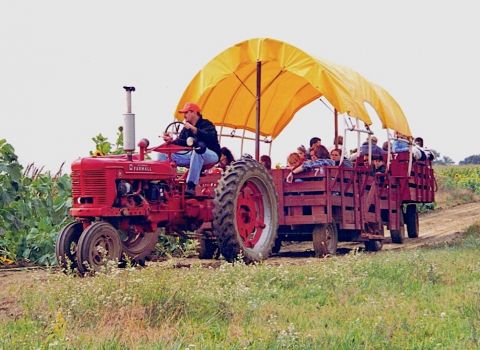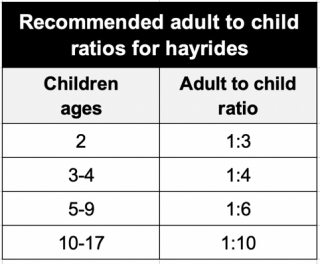
Vol. II, No. 4, August 2024
Hayride safety essentials
Since the fall hayride season is just around the corner, we're republishing the hayride safety standards we've published in past articles.
Hayrides are a popular and enjoyable attraction for visitors at agritourism farms. However, hay wagon rides can be extremely dangerous if not operated safely. Our research shows that since the year 2000, hayride accidents have caused 167 injuries and the death of at least 22 people, including 14 children.

Over our company's 29 years of agritourism consulting and design work, we have visited very few farm operations safely operating their hayrides. We have always prioritized advising our clients on needed improvements to make their hayrides safe. And fortunately, most followed our advice, making visiting their farms much safer.
Here's a summary of essential safety design and operating procedures that every farm or venue that operates a hayride should follow:
- The hayride route should have non-climbable barricade-type fencing along its route whenever it is in or near areas where visitors will be so there is no possibility of anyone, especially children, wandering into the path of the hayride. The hayride path should NEVER cross or travel through any areas that the public has access to. At the loading and unloading areas, the fencing should have gates operated only by the loading/unloading staff.
- The hay wagon must have railings and seating. Enclosure railings should be designed to prevent children from crawling through or climbing them. The front bulkhead railing must be adequately tall, at least 30" and sturdy to prevent anyone from falling forward out of the wagon and being run over. If the front of the wagon has seats or haybales for seating, the bulkhead railing should be 30" higher than the seating, as children will stand on the seats. There should be sturdy steps with handrails. The loading opening on the wagon should have a gate or enclosure that is kept shut other than when loading or unloading. Double wagons should NEVER be used.
- The loading area should have a sign with the safety rules for passengers.
- Before loading or unloading, the tractor should come to a complete stop, be put in neutral, and have the brake engaged. If the average grade of the ground is greater than 2%, the driver should remain on the tractor.
- Only after the tractor stops in the unloading area, is put in neutral, and the brake engaged should the unloading staff open the wagon gate and assist people off.
- Once a wagon is loaded, verbal safety instructions should be given to the riders, the loading staff should close the barricade exiting gate, the tire inflation on the wagons and tractor should be eyeballed, and the area around and under the wagon inspected to make sure there are no people or children, and only then should the tractor driver be signaled to proceed.
- There should be well-organized written loading and unloading procedures that staff are trained on.
- Ideally, communication between the loading staff and the driver should be via two-way radio. Otherwise, the driver's go-signal should be visual, crystal clear, and not mistakable.
- The hayride path should be kept smooth as depressions and ruts can cause wagons to grab hold and jerk, bouncing riders around. There should be no steep areas. All trees and bushes along the path must be trimmed so branches won't hit riders. The trail should NEVER cross a public road.
- Tractors and hay wagons should be thoroughly inspected at the beginning of each day. There should be a written inspection checklist where the drivers check off each item and sign and date the sheet. This helps ensure that the procedures will be appropriately followed.
- A tamper-proof locking hitch pin must connect the wagon to the tractor. The wagon must have a safety chain connecting the wagon's front axle to the tractor's drawbar or rear axle.
- Tractors should have rear-view mirrors that give a full view of the wagon.
- For adequate traction and braking, the tractor pulling the wagon should weigh more than the gross weight of the wagon when full of people.
- All wagons should have a tour guide riding in the wagon with two-way radio communication with the tractor driver. Tractor noise prevents a driver from hearing anything shouted from the wagon if there is a problem.
- The hayride should NEVER go on public roads. In 1989, in New Brunswick, Canada, 13 wagon riders died, and 45 were injured when a logging trailer crashed into a hayride. In 2016, in Chucky, Mississippi, three people were killed when a pickup truck rear-ended a hay wagon traveling on a public road.
- Due to the hazardous nature of hayrides, children's field trip hayrides should have higher adult-to-child ratios than classroom ones. The chart shows recommended ratios.
- Training is essential for all staff involved. All tractor drivers should be trained in the operation of the tractor they will be driving, including how to properly start and stop smoothly and on driver safety rules. They should be given a tractor driver road test. Just because employees know how to drive a tractor does not mean they understand how to drive a hayride. All employees responsible for loading, unloading, and supervising hayrides must also be trained. There should be a pocket-size checklist of all procedures each staff member keeps and uses.
- There should be safety rules and training for actors and staff of haunted hayrides.
- Daily checklists should be developed for the hayride route,
tractors, and wagons and filled out at the beginning of each day. There
should be annual tractor and wagon checklists. Here's a list of them:
- Daily hayride path inspection checklist
- Daily tractor checklist
- Daily wagon checklist
- Annual wagon checklist
- Annual tractor checklist
- Rider safety rules, including signage
- Driver safety rules
- Tractor driver road test
- Procedures and training for unloading and loading staff
- Safety rules for haunted hayride actors and staff

Hayrides are a great fun attraction for visitors. Just make sure you take the time and effort to operate yours safely.
Subscribe to Agritourism Today



